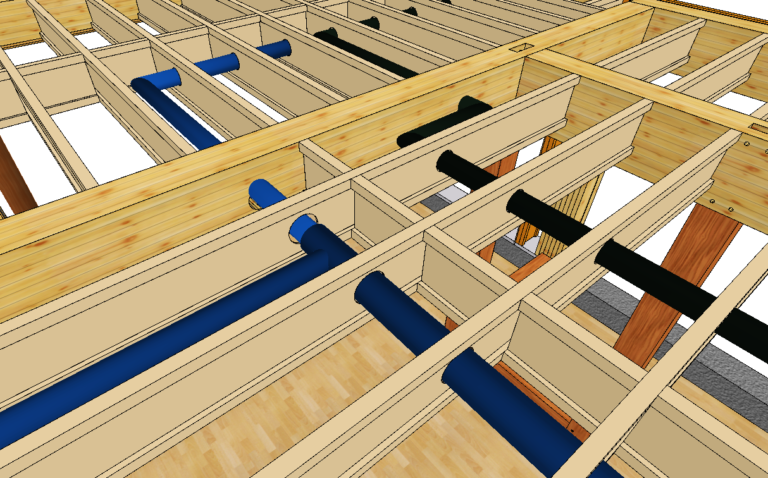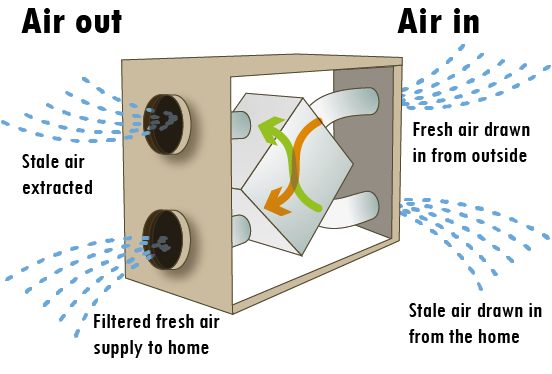Mango Projects Ltd
What is an MVHR unit?
A MVHR (Mechanical Ventilation with Heat Recovery) is a full house system that removes stale, wet air from kitchens and bathrooms, takes the heat out of that air (Heat Recovery) and uses that heat to warm incoming fresh air from outside. This incoming air is then ducted into the living spaces (living rooms, bedrooms) of the house.
To achieve this, ducting is installed from the machine to each room in the house, usually via a ‘branch’ network of ducts. On nearly all of our new build projects we use rigid steel ductwork since this is by far the best in terms of robustness, quietness and ease of cleaning in the future. These ducts start as large diameter (160mm) near the machine, branching down to 100mm at each room valve, here’s how that looks in a set of floor joists:

When working on retro-fit installs it can be impossible to use rigid steel ductwork, so we can compromise on these projects by using a strong smooth bore flexible duct work, often with a duct distribution via plenum boxes to each room, with most of the ducting through the loft. The ducts must be set within the roofing insulation, or be insulated themselves, where this is not possible.
We often find when retrofitting chalet style bungalows and other builds of that type that there is useful space in the eaves where ducting can be installed, so long as the space is on the warm side of the building. If there is no option and some ductwork ends up on the cold side, it must be very well insulated as part of the install.
We offer a complete design, installation and commissioning package to our clients, using only the most efficient machines and the best duct work available. All of our systems are acoustically modelled within our software so silencers are implemented in the duct layout as required to ensure our systems have near silent running.
You cannot compromise on MVHR, our motto is: Install once, install correctly.

In addition to being warmed, the MHVR systems filter the fresh air from outside, removing particulates, dust, pollen and other allergens and irritants.
This is great news for you if you live in a city with poor air quality or if anyone in your family suffers respiratory diseases like asthma, COPD or hay fever.
The MVHR machine slowly and quietly constantly exchanges all the air within the home with filtered fresh air from outside, creating very high comfort levels and low levels of moisture, eradicating the problem of mould growth and subsequent toxic sporing around areas where the air is stale, creating a healthier living environment.

The entire interior of the building is kept fresh, clean and comfortable throughout, all year long, no matter what the conditions are outside.
Am I living in an air-tight home, and do I need and MVHR?
This is a relatively new technology set that shamefully, large scale building companies have been slow to adopt. Typically, MVHR units are installed in existing homes as part of a major upgrade such as bringing a home to reach EnerPHit standard, or on new passivhaus homes that have been self-built or commissioned privately.
We have substantial experience with new build timber frame passivhaus homes since the mid 1990’s.
Could I convert my home to be more ‘passivhaus’?
In many cases, yes!
It cannot be argued that the initial cost of converting an existing build to be ‘near passivhaus’ is cheap, but the benefits you reap very quickly pay back. For a start, you will pay much lower energy bills, if any. Many of the homes we have built have recorded very low running costs.
The air inside your home would be kept clean, fresh and odourless which is extremely helpful for those suffering health conditions or are sensitive to seasonal allergies. The air-tightness and insulation measures we would implement are also highly effective at eradicating noise pollution, and prevent your neighbours being subject to any noise you might enjoy, so you can rock that bass guitar, or even those bagpipes!
And then finally, and maybe most importantly, the less energy we use, the less we contribute to climate change and air pollution as a whole.

